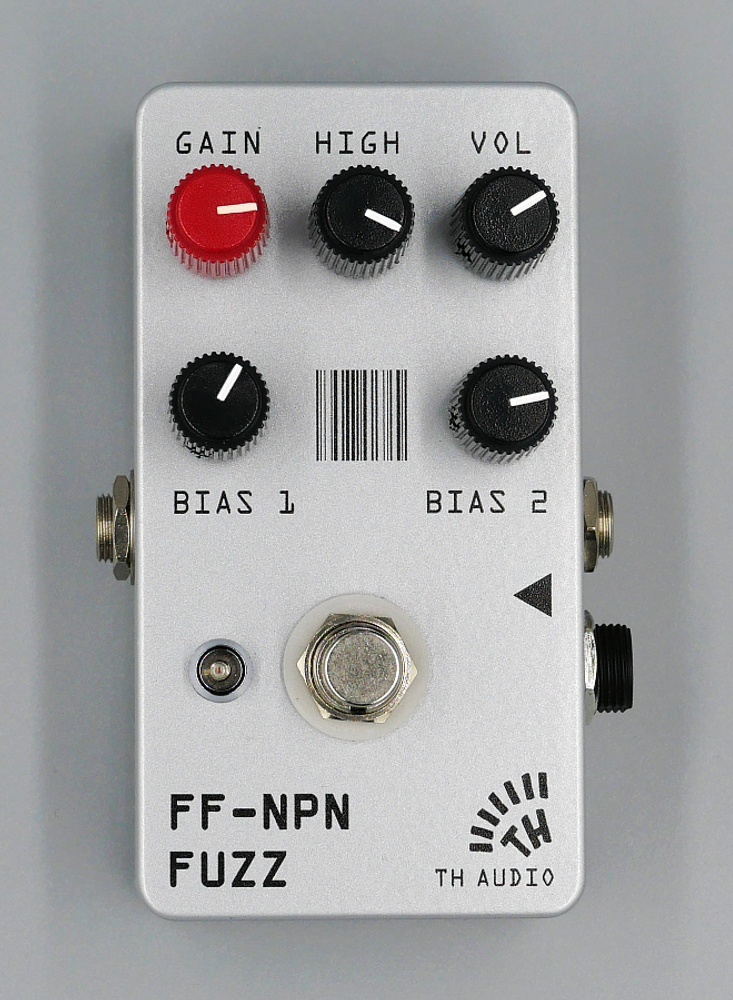As with the fuzz units that TH Audio has offered in the past, the fuzz-producing transistors in the FF-NPN are socketed, not soldered in place. But unlike older TH Audio fuzz units, the biasing elements are on the outside of the unit as adjustable knobs, instead of on the inside as trimpots.
As of 2023, I can build about 20 of these with a small stash of Germanium transistors. Or, I can use Silicon transistors by request. Both of these transistors can be easily replaced, and re-biased with the Bias-1 and Bias-2 controls on the outside of the pedal.
No two of these will sound quite the same (or bias quite the same).
See the 'Videos' tab for more.
The FF-NPN will arrive ready to plug in and play. However, you might want to adjust the 'Bias' controls to taste, especially if you live somewhere with a different humidity level than California, which is where these are assembled. Changes in humidity and temperature can affect the way Germanium transistors handle an audio signal.
Controls
Row 1:
Gain This knob controls, you guessed it, the amount of fuzz-ness.
High Turning this knob counterclockwise will roll off high frequencies.
Vol This knob controls, you guessed it, the output volume. Unlike 'canonical' fuzz-face units, rolling this knob back doesn't cause major loss of high frequencies.
Row 2:
Bias 1 This knob controls biasing for the first fuzz transistor. Turn it back and forth until you hear amp noise. Listen a little and you'll probably be able to find a suitable 'open' position. Or, if you want really extreme gating, turn it until you hear that, which usually won't have any background noise at all. Specifically, this potentiometer controls the resistance between the collector of Q1 (the first fuzz transistor) and the positive voltage supply (which is positive - the transistors are NPN, not PNP).
Bias 2 This knob controls biasing for the second fuzz transistor. Turn it back and forth until you hear a suitable fuzz response. On one end, it will probably sound burp-y and un-musical. On the other end, the signal will probably be too weak. Specifically, this potentiometer controls the resistance between the collector of Q2 and the audio signal to the output buffer.
Note: Bias 1 and Bias 2 can affect each other. If you put a new pair of transistors in the FF-NPN, a good way to start is to find the best non-gated position for Bias 1, and then work with Bias 2 until you find the proper tone and signal strength.

Swapping Transistors
The image above shows a pair of CV7351 Germanium transistors in the sockets (in a testing unit).
You could:
-
Leave the interior alone and use the pedal as-is (recommended if you just want to play).
-
Adjust the Bias-1 and Bias-2 without replacing either of the FF (fuzz-face) transistors.
-
Replace one or both of the FF transistors, and re-bias with the knobs.
'FF' means the transistors that produce the beloved square-wave fuzz signal. There are two other transistors in there (little black bug-looking things) but they're soldered in and you'd want to leave them alone obviously (they're JFETs that serve as part of a buffer for the output signal).
If you do swap out the FF transistors, keep in mind that Silicon transistors will sound different than Germanium transistors, and when Q1 and Q2 are both Silicons, the output can be very aggressive and noisy.
Notes
If you replace the transistors...
1. Use NPN transistors, not PNP.
2. Try not to touch the leads with your fingers - the static charge in your body can do bad things to the transistor.
3. Disconnect any audio cables from the unit so that power to the circuit is shut off. It's probably a good idea to disconnect the battery too.
4. With pliers, slowly pull the mounted transistors out of the sockets. Don't pull too hard, and don't wiggle them too much - you don't want to strain the leads.
Whether you cut the legs of the transistors, and whether you bend them, is up to you. I always audition the transistors before I ship them with a unit, so, the legs will be bent more or less the way they should be mounted in the socket. Many, but not all, NPN transistors have a small tab on the housing somewhere that coincides with the position of the emitter leg. If the leg closest to this tab is the emitter, it can be lined up with the hole nearest to the tab on the sockets on the FF-NPN circuit board. (which is where the emitter goes).
The FF-NPN Fuzz features:
- True bypass switching
- Hammond enclosure
- Switchcraft jacks
- Heat-treated silkscreened graphics
All TH Audio pedals are handbuilt and tested in the United States of America.







